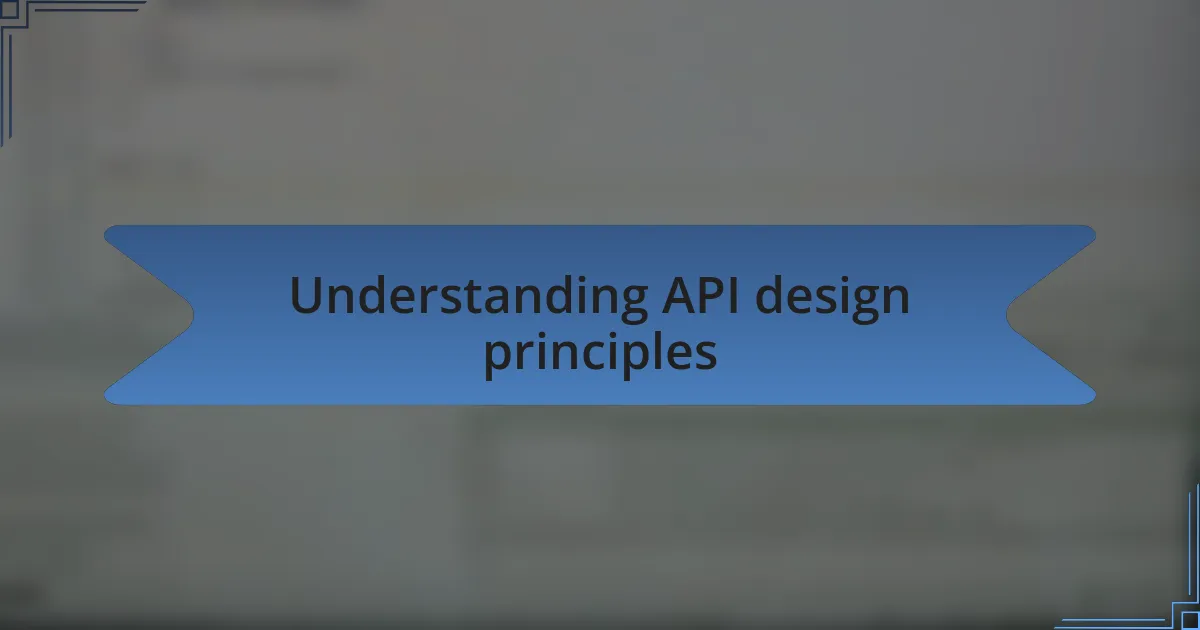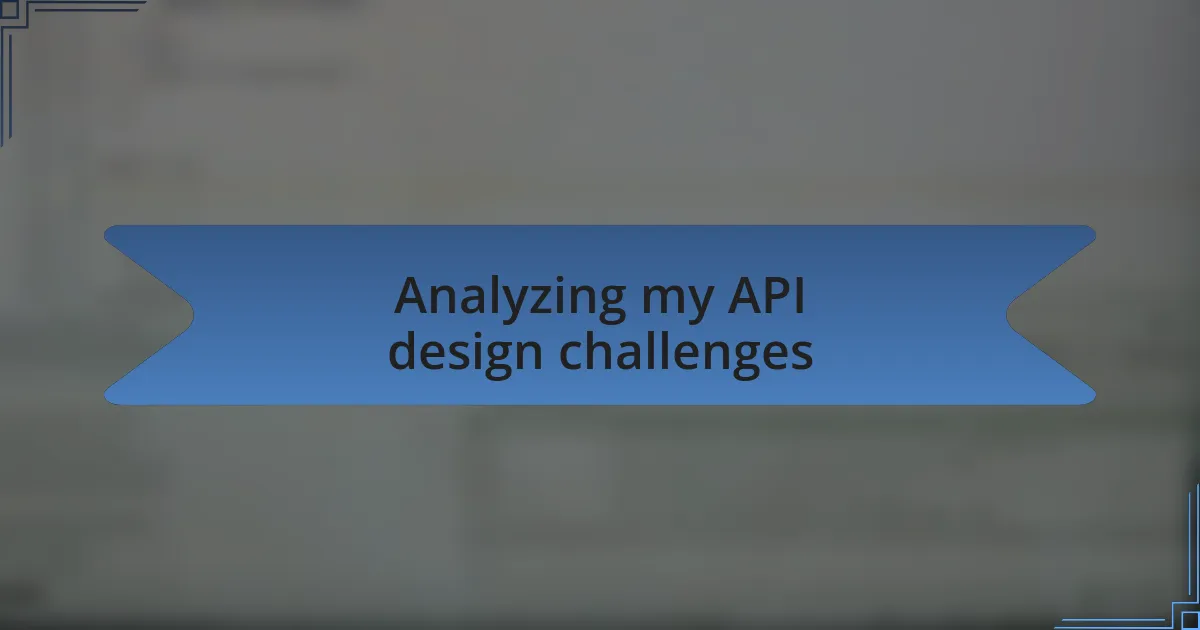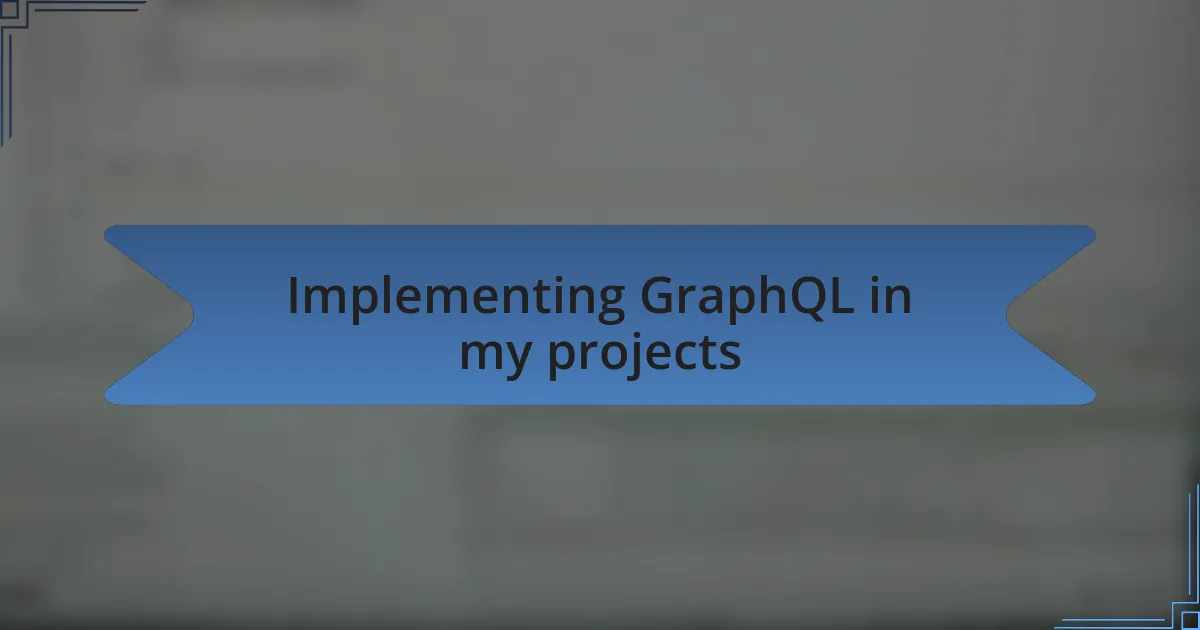Key takeaways:
- Effective API design prioritizes clarity, consistency, and usability, significantly enhancing the developer experience.
- GraphQL streamlines data retrieval through a single endpoint, reducing over-fetching and under-fetching, and encourages critical thinking about data structures.
- Transitioning from REST to GraphQL involves rethinking caching and authentication, but offers benefits like self-documentation and real-time capabilities.
- Investing time in crafting a well-structured schema and understanding client flexibility leads to more efficient and maintainable API designs.

Understanding API design principles
Good API design principles are foundational to building effective software. Just think about it: how often have you struggled with an API that lacked clear documentation or had an inconsistent structure? I once spent hours debugging an integration because the API’s endpoints were poorly designed, driving home the importance of clarity and consistency in every aspect of API design.
Moreover, prioritizing usability means designing APIs that are intuitive for developers. I remember the relief I felt when I encountered a well-structured API that followed naming conventions—like predictable resource naming—which made it feel like the API was speaking my language. It’s essential to consider how easily other developers can grasp not just how to use the API, but also its underlying logic.
Another key principle is to minimize the need for multiple requests. When I was migrating a project to use GraphQL, the transformation highlighted how a well-designed API could condense what used to take several requests into one. Can you imagine the efficiency? It resonated with me that a thoughtful approach to API design not only enhances performance but also leads to a better developer experience overall.

Introduction to GraphQL technology
GraphQL is a powerful query language for APIs that fundamentally changes how we interact with data. I first encountered it during a project overhaul, and I was immediately struck by its ability to streamline data retrieval. Instead of receiving a fixed set of data from an endpoint, I could specify exactly what I needed—like crafting a personalized request that only returned specific fields.
One of the most striking features of GraphQL is its single endpoint, which simplifies the architecture. This belies the complexity of traditional REST APIs that often require navigating multiple endpoints. I remember thinking about how much time I wasted managing various URLs and parameters. With GraphQL, I felt a sense of liberation; no longer was I tied down by the rigid structure of REST.
Moreover, GraphQL inherently encourages developers to think critically about their data structure. As I explored its schema-driven approach, I realized how this promotes better design practices. Can you imagine how insightful it was to visualize the relationships between different data points? It inspired me to not only improve my API design but also to understand the underlying business logic more profoundly.

Benefits of using GraphQL
One of the standout benefits of using GraphQL is its ability to reduce over-fetching and under-fetching of data. I recall when I initially transitioned to GraphQL; I could request exactly what I needed, down to the last field. This flexibility meant no more guessing games about how much data was necessary for a single view. It’s like changing from a buffet where you take everything on the table to ordering just the dish you crave—transformation at its finest.
Another advantage I truly appreciate is the strong typing system that GraphQL introduces. When I implemented it in my projects, I felt an increased confidence in my API interactions. Each type and field outlined in the schema acted as a contract. It made debugging a breeze since I could quickly identify mismatches or issues. Have you ever spent hours tracing a bug in an API response? With a well-defined schema, those worries diminished significantly, allowing me to focus on enhancing features instead of putting out fires.
Then there’s the real-time data handling capabilities with GraphQL subscriptions. I remember integrating live updates into one of my applications and was amazed at how elegant the solution was. Instead of polling the server continuously, I leveraged subscriptions to receive updates through a single connection. This not only optimized performance but also provided a seamless experience for users. Isn’t it refreshing when technology simplifies complexity and enhances user experience?

Analyzing my API design challenges
Designing APIs, I encountered several challenges that pushed me to rethink my approach. One major hurdle was ensuring that my endpoints could efficiently handle the diverse needs of different clients. I vividly remember the frustration when users would call for data that wasn’t readily available. That experience taught me the importance of understanding user requirements upfront—what a game changer it was to consult with users at the beginning!
Another challenge was maintaining consistency across my API responses. Early in my journey, I often had different responses based on the same endpoint but under varying parameters. This inconsistency confused not only my users but also my own team. I vividly recall the late-night discussions on how to standardize outputs; it led me to the realization that a uniform response structure was crucial. Has anyone else felt that tug-of-war between agility and stability in API design?
Lastly, I battled with versioning my APIs without causing disruption. I remember deploying a new version and suddenly users were thrown off by expected functionalities disappearing. It was more than just technical; there were real emotions involved, like letting down users who relied on my service. I quickly learned that a thoughtful approach to deprecation and clear communication is paramount. It’s amazing how much smoother the process became when I prioritized these aspects from the very start.

Transitioning from REST to GraphQL
Transitioning from REST to GraphQL was a pivotal moment in my API journey. I recall the initial skepticism I faced from my team; they were comfortable with REST. But after demonstrating how GraphQL could reduce over-fetching and under-fetching of data, their intrigue grew. It felt rewarding to see them excited about the possibility of fetching exactly what we needed in one query, rather than juggling multiple endpoints. Have you ever felt the spark of innovation when a new tool finally clicks with your team?
One of the most significant benefits I experienced during this transition was the power of self-documentation GraphQL offers. As I migrated our API, I found myself entranced by GraphQL’s schema. It was like having a living, breathing document that updated as we developed, making onboarding new team members much smoother. I remember a particularly chaotic week where we struggled to explain our existing REST endpoints to a new hire. With GraphQL, my heart swelled with pride as I effortlessly showcased how intuitive it had become to see the available data at a glance. Have you ever wished for a magic wand to make complex API structures simpler?
However, the path wasn’t without its bumps. Migrating to GraphQL meant rethinking how we managed caching and authentication. I vividly remember wrestling with these concepts as our old solutions felt inadequate. There were moments of doubt when I’d question whether this shift was worth the investment of time and effort. Yet, those challenges ultimately pushed me to understand the strengths and weaknesses of both approaches in a way I never had before. It taught me the importance of embracing discomfort in the name of progress. Would you agree that facing these hurdles often leads to the most significant growth?

Implementing GraphQL in my projects
Implementing GraphQL into my projects was both exciting and daunting. I still remember the first time I set up a GraphQL server; it felt like constructing a puzzle where each piece molded together seamlessly. As I specified the types and queries in the schema, I could already envision how much easier it would be for the frontend team to consume our API. Have you ever felt that rush when everything clicked into place?
As I began integrating GraphQL, I realized that real-time capabilities were a game-changer for my applications. One project, in particular, involved a messaging feature where users could see updates instantly without refreshing the page. Implementing subscriptions was a bit challenging at first, but the payoff was immense. Watching users interact with our app in real-time brought a satisfaction I hadn’t anticipated. Doesn’t it feel great when you see your work come to life through user feedback?
Throughout this process, I sharpened my skills in error handling and query optimization. Initially, I struggled with how to relay meaningful error messages back to the client. I distinctly remember a late night spent tweaking error handling in our GraphQL server. Eventually, I crafted responses that not only informed users of what went wrong but also guided them on how to resolve their issues. It was a turning point that made me believe in the power of clear communication in coding. Have you experienced a similar breakthrough that changed your approach to development?

Lessons learned from my experience
Lessons learned from my experience:
One significant lesson I gleaned from working with GraphQL was the importance of crafting a well-structured schema. At first, I was eager to jump right into queries and mutations, but I discovered that investing time in designing a thoughtful schema made a world of difference. Have you ever noticed how a solid foundation can make or break a project? This realization transformed my approach to API design, ensuring that the overall architecture supported scalability and maintainability.
Another key takeaway revolved around the power of client-side flexibility. I vividly remember a meeting where our frontend team expressed their frustrations with RESTful endpoints. Their enthusiasm when they realized they could query exactly what they needed was inspiring. Could you imagine the satisfaction of turning client requests into simple queries? This shift not only fostered better collaboration but also allowed us to respond to changes more swiftly, making our development cycle much more efficient.
I also became acutely aware of the nuances of performance. Early on, I overlooked the impact of inefficient queries, which initially led to slow response times. I recall a tense moment during a demo when the app lagged, causing embarrassment. That experience pushed me to explore tools like DataLoader for batching and caching, which ultimately elevated our API’s efficiency. Have you ever faced a challenge that motivated you to dive deeper into optimization? It was a humbling moment that taught me the value of continuous improvement and monitoring.